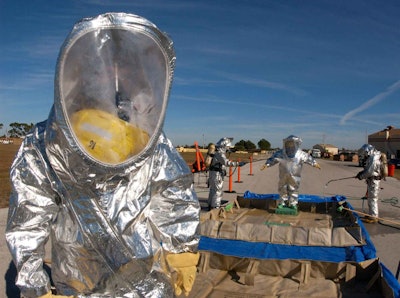
Take one look at an old coal and gas energy site and the content filling Sunday’s “60 Minutes” episode on CBS doesn’t look shocking.
It looks par for the course.
Duke Energy, both in the episode segment on the Dan River coal ash spill and in media and politics since the spill, has the spotlight on it for problems with industrial waste pollution.
According to the Lenoir County Multi-Jurisdictional Hazard Mitigation Plan, there's a number of hazardous materials sites either once or currently considered an area of concern by the state Department of Environment and Natural Resources and the federal Environmental Protection Agency.
In downtown Kinston sits the site of the former Kinston manufactured gas plant, which provided energy from 1925 until its shutdown from obsolescence in 1952.
A document prepared in October 2012 by Silar Services for Progress Energy—now merged with Duke Energy—and submitted to the DENR Superfund Section details 22 years of work at the site.
A local resident’s complaint in 1990 led to an investigation of an oily discharge emanating from the property and flowing into the Neuse River from an old city stormwater pipe. DENR issued a violation citation to N.C. Natural Gas, the owner at the time, in July 1991.
Following the discovery of continued pollution of the river from the site in 1999, investigators revealed not one, but two “ancient buried stream” channels that were previously unknown. That led to the construction of a retaining wall between the site and the property.
Gov. Pat McCrory said on “60 Minutes” he doubted Duke Energy knew the extent of the conditions under the Dan River plant’s ponds or other similar ones throughout the state. That appeared to be the case with the subterranean streams running under the old gas facility near the corner of South Herritage and West South streets.
Frank Holleman, senior attorney with the Southern Environmental Law Center—which has been involved in legal action against Duke Energy for its coal ash practices—said the severity of the problem in an area contaminated with hazardous waste and its danger to people and other living things changes from situation to situation.
“It would turn on the specifics of how the stuff is stored, how close it is to a waterway and what it is,” Holleman said. “As you know, for instance, we saw in West Virginia, near Charleston, W.Va., where they would hold chemicals stored in containers that then contaminated the drinking water supply because they were close to the river.
“And of course with coal ash and the Dan River we’ve seen how old infrastructure can rot away and result in unsafe storage, causing a catastrophic failure.”
Duke Energy continues monitoring and maintenance at the former gas plant property, and readings from 2012 continued to show unacceptable amounts of—among a host of other chemicals—arsenic, benzene, ethylbenzene, naphthalene, xylenes and the like in groundwater and soil in monitoring wells on the property.
A sizable portion of the site was also covered with gravel to limit surface contact with any remaining chemicals.
And the gas plant is just one example out of five. Not too far away was a small detergent business a tornado destroyed in March 1991. The damage spread dangerous chemicals across the property, including hydrochloric acid, phosphoric acid and caustic soda.
“In August of 1992, an EPA removal team assessed the environmental hazards and remediated the site,” according to the county Hazard Mitigation Plan. “The acids and bases that were exposed to the environment were sampled and then neutralized. The wastes were categorized by waste stream, drummed and removed from the site. …
“Trace amounts of binary and complex salts and sodium phosphate that were left on site were determined not to pose any significant threat to the environment.”
Then there’s Borden Chemical’s N.C. 11 site known as the Elmer Catch Pond that collected about 360 pounds of pesticides and 720 pounds of solvents and surfactants beginning in 1967. The company worked with state and federal regulators on closing the site and there’s no further action recommended.
A DuPont site on N.C. 11, now owned by Reliance Industries, was the location of 120,000 gallons of burned acetone, acids, methanol and waste lubrication oils from 1953 to the closing of waste burning and pits under state order in 1980. Monitoring showed no impact to groundwater and the pits were closed and solidified using wood ash.
Last, the old Kinston/Lenoir County landfill off U.S. 70. A site for disposal from 1960 to almost complete closure by state order in 1981, in the early 1970s it received about 3,600 pounds of pesticide wastes that included DDT, parathion, Sevin and toxaphene. An earthen dam ostensibly protects the Neuse River from chemicals remaining at the site, prohibiting water to enter or leave the location.
State and federal regulators ruled no further action should be taken at the landfill by the mid-1990s.
Duke CEO Lynn Good said in her interview Sunday that hazardous industrial matters like coal ash sites don’t have quick or easy solutions.
“As much as I would like to tell you there’s a simple solution, it’s one that requires study and one that requires time to complete,” Good said.
Lenoir County Emergency Services Director Roger Dail wasn’t available for comment Monday, but according to the Hazard Mitigation Plan, because such hazardous materials sites do pose a danger to living things should a catastrophic event occur, there has to be a plan in place to deal with the problem as early as possible.
“Natural disasters, such as floods and earthquakes can cause hazmat releases or disturb old hazmat release sites,” the plan states. “These same disasters can make it difficult to contain these events once they occur.
“Also, these same natural disasters can limit access to the spill, waterlines for fire suppression may be broken, and response personnel and resources may be limited. Flooding and high winds can quickly spread the contaminant, threatening agriculture, water supply and air.”























